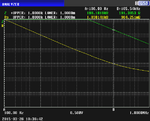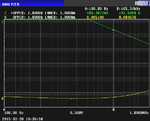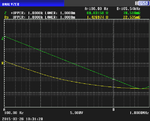David_
Advanced Member level 2
Hello.
I just bought the following:
ceramic 1µF 100V 10% X7S 0805.
ceramic 0.1µF 100V 10% X7R 0805.
ceramic 10nF 100V X7R 0805.
polymer 12µF 80V 20% 50mΩ ESR.
And some more but it is these four that I have measured, which gave these results.
the first pair of values are at 100Hz, second is 1kHz, then 10kHz and 100kHz using my mastech MS5308 LCR Meter:
1µF cer:
960nF/21Ω 936nF/2.2Ω 900nF/0.16Ω 905nF/0.01Ω
0.1µF cer:
94nF/186Ω 92.3nF/20.6Ω 90.5nF/2.2Ω 87.9nF/0.2Ω
10nF cer:
10.2nF/1.5kΩ 10.07nF/194Ω 9.83nF/30Ω 9.52nF/4.95Ω
12µF poly:
13.2µF/1.6Ω 12.95µF/0.25Ω 12.63µF/0.08Ω 14.65µF/0.04Ω
Now the polymer electrolytic checks out, my meter shows ESR when calculating as a series model and if I choose parallel on 100kHz it shows near 12µF.
But what about the ceramic, I guess the 1µF is not bad since it is for higher frequency's as the a mainly if not only for decoupling.
But the 10nF at 100kHz shows 4.95Ω!!! That aint low...
Nor is 200mΩ for the 0.1µF, but then again this is the first ones that I have bought and they are better than the ones I have de-soldered for the most part.
Is this normal values?
What is good values?
How do you separate a bad/low quality ceramic from a good/high quality one?
Regards
I just bought the following:
ceramic 1µF 100V 10% X7S 0805.
ceramic 0.1µF 100V 10% X7R 0805.
ceramic 10nF 100V X7R 0805.
polymer 12µF 80V 20% 50mΩ ESR.
And some more but it is these four that I have measured, which gave these results.
the first pair of values are at 100Hz, second is 1kHz, then 10kHz and 100kHz using my mastech MS5308 LCR Meter:
1µF cer:
960nF/21Ω 936nF/2.2Ω 900nF/0.16Ω 905nF/0.01Ω
0.1µF cer:
94nF/186Ω 92.3nF/20.6Ω 90.5nF/2.2Ω 87.9nF/0.2Ω
10nF cer:
10.2nF/1.5kΩ 10.07nF/194Ω 9.83nF/30Ω 9.52nF/4.95Ω
12µF poly:
13.2µF/1.6Ω 12.95µF/0.25Ω 12.63µF/0.08Ω 14.65µF/0.04Ω
Now the polymer electrolytic checks out, my meter shows ESR when calculating as a series model and if I choose parallel on 100kHz it shows near 12µF.
But what about the ceramic, I guess the 1µF is not bad since it is for higher frequency's as the a mainly if not only for decoupling.
But the 10nF at 100kHz shows 4.95Ω!!! That aint low...
Nor is 200mΩ for the 0.1µF, but then again this is the first ones that I have bought and they are better than the ones I have de-soldered for the most part.
Is this normal values?
What is good values?
How do you separate a bad/low quality ceramic from a good/high quality one?
Regards



